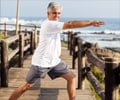Can exercise lower the risk of respiratory infection risk in children? Yes, higher levels of daily physical activity reduce susceptibility to the common cold.

Participants wore a pedometer armband 24 hours a day for 40 days to measure their activity levels and sleep duration. Parents reported their children’s symptoms of upper respiratory tract infections — such as coughing or sneezing — using daily questionnaires for 60 days.
Using a second questionnaire, parents reported on their children’s vaccinations, participation in sports, whether they had siblings, and their exposure to smoking and pet hair.
Kids who Exercise More are Less Likely to Get Respiratory Infections
Researchers found that as the average daily number of steps taken by children throughout the study period increased by 1,000, the number of days that they experienced symptoms of upper respiratory tract infections decreased by an average of 4.1 days.Additionally, children participating in three or more hours of sport per week tended to experience fewer days with respiratory tract infection symptoms than those not regularly participating in sports. Higher activity levels at the beginning of the study were associated with fewer days with respiratory tract infection symptoms during the following six weeks.
Among 47 children whose average daily number of steps was 5,668 during the first two weeks of the study period, the combined number of days during the following six weeks that these children experienced upper respiratory tract infection symptoms was 947.
However, among 47 children whose initial average daily steps numbered 9,368, the combined number of days during the following six weeks that these children experienced respiratory symptoms was 724.
Advertisement
They also suggest that skeletal muscles could release small extracellular vesicles that modulate immune responses following exercise. However, they caution that future research is needed to investigate these potential mechanisms in children.
Advertisement
Source-Eurekalert















